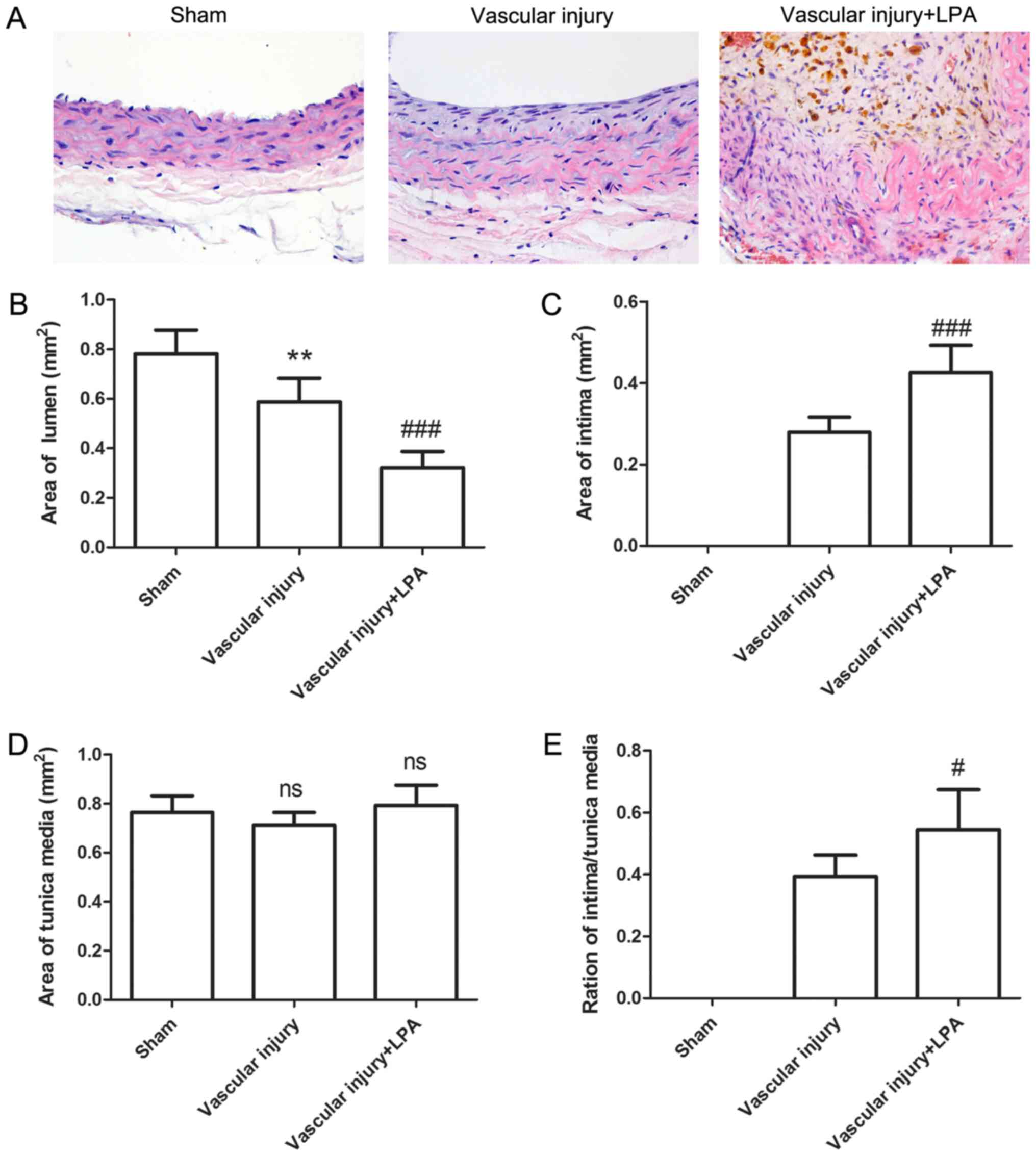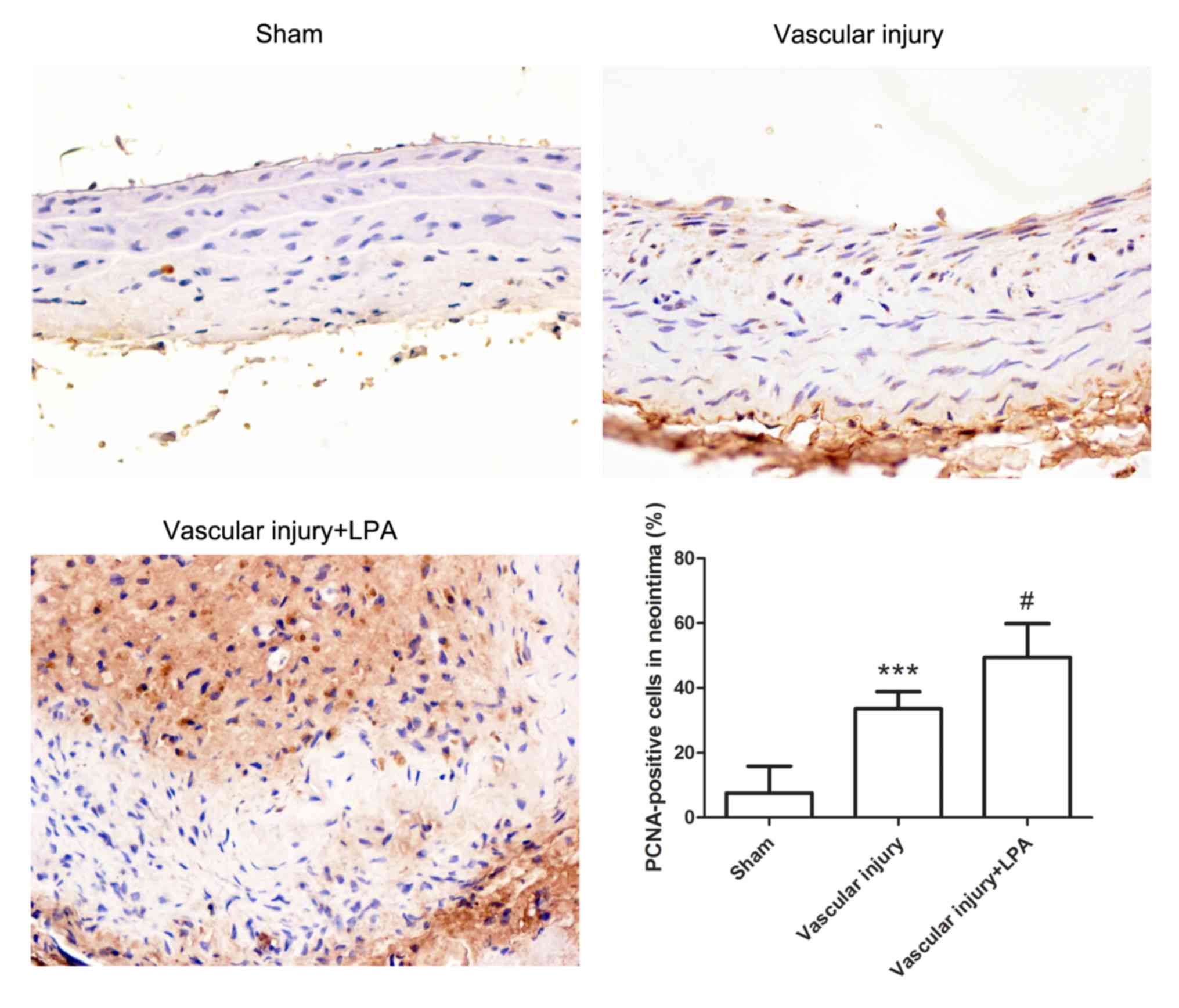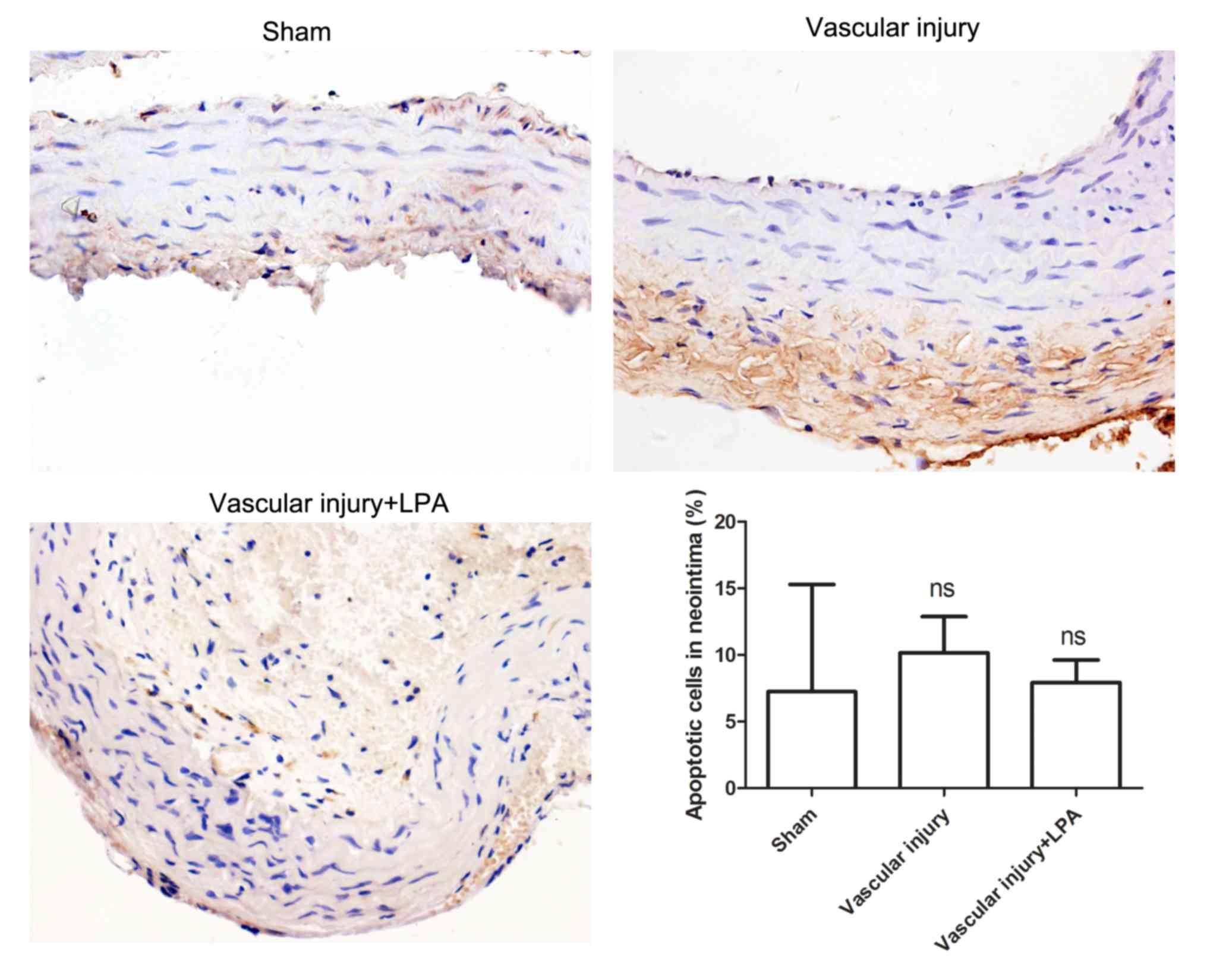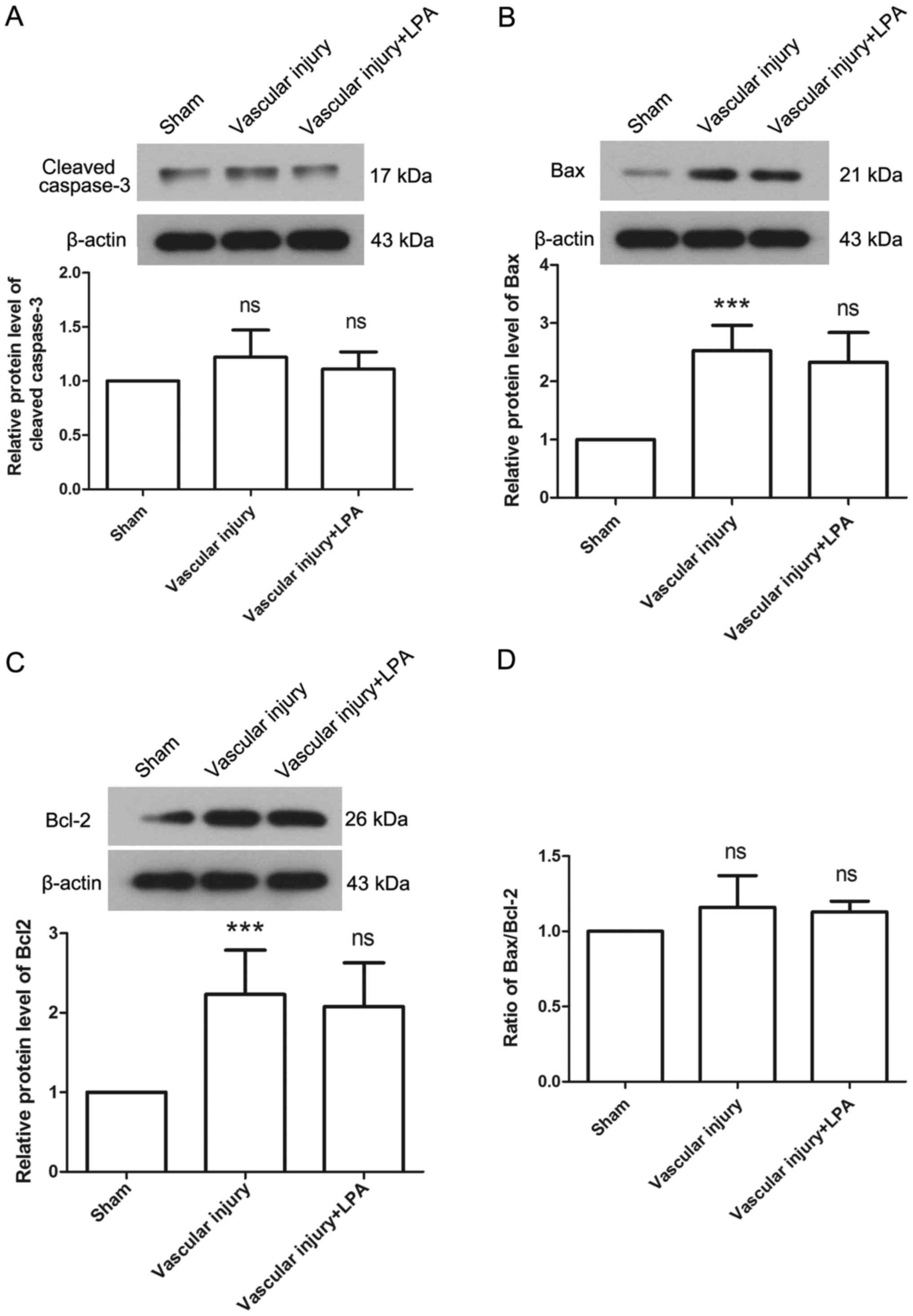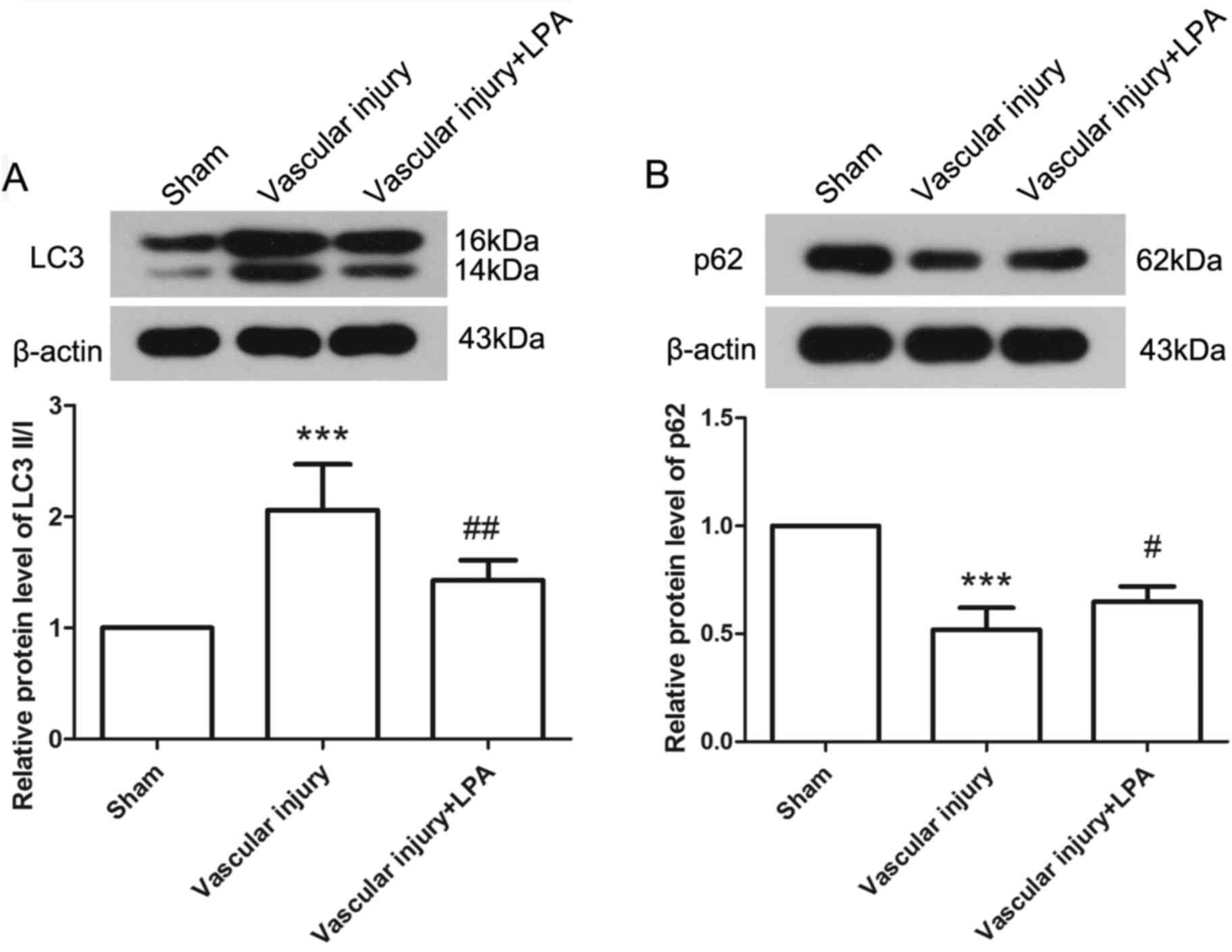|
1
|
Weber C and Noels H: Atherosclerosis:
Current pathogenesis and therapeutic options. Nat Med.
17:1410–1422. 2011. View
Article : Google Scholar : PubMed/NCBI
|
|
2
|
Schober A and Siess W: Lysophosphatidic
acid in atherosclerotic diseases. Br J Pharmacol. 167:465–482.
2012. View Article : Google Scholar : PubMed/NCBI
|
|
3
|
Zhang C, Baker DL, Yasuda S, Makarova N,
Balazs L, Johnson LR, Marathe GK, McIntyre TM, Xu Y, Prestwich GD,
et al: Lysophosphatidic acid induces neointima formation through
PPARgamma activation. J Exp Med. 199:763–774. 2004. View Article : Google Scholar : PubMed/NCBI
|
|
4
|
Clowes AW, Clowes MM, Fingerle J and Reidy
MA: Regulation of smooth muscle cell growth in injured artery. J
Cardiovasc Pharmacol. 14 Suppl 6:S12–S15. 1989. View Article : Google Scholar : PubMed/NCBI
|
|
5
|
Fuster JJ, Fernandez P, Gonzalez-Navarro
H, Silvestre C, Nabah YN and Andres V: Control of cell
proliferation in atherosclerosis: Insights from animal models and
human studies. Cardiovasc Res. 86:254–264. 2010. View Article : Google Scholar : PubMed/NCBI
|
|
6
|
Lusis AJ: Atherosclerosis. Nature.
407:233–241. 2000. View
Article : Google Scholar : PubMed/NCBI
|
|
7
|
Sheng X, Yung YC, Chen A and Chun J:
Lysophosphatidic acid signalling in development. Development.
142:1390–1395. 2015. View Article : Google Scholar : PubMed/NCBI
|
|
8
|
Choi JW, Herr DR, Noguchi K, Yung YC, Lee
CW, Mutoh T, Lin ME, Teo ST, Park KE, Mosley AN and Chun J: LPA
receptors: Subtypes and biological actions. Annu Rev Pharmacol
Toxicol. 50:157–186. 2010. View Article : Google Scholar : PubMed/NCBI
|
|
9
|
Lin ME, Herr DR and Chun J:
Lysophosphatidic acid (LPA) receptors: Signaling properties and
disease relevance. Prostaglandins Other Lipid Mediat. 91:130–138.
2010. View Article : Google Scholar : PubMed/NCBI
|
|
10
|
Smyth SS, Cheng HY, Miriyala S,
Panchatcharam M and Morris AJ: Roles of lysophosphatidic acid in
cardiovascular physiology and disease. Biochim Biophys Acta.
1781:563–570. 2008. View Article : Google Scholar : PubMed/NCBI
|
|
11
|
Siess W and Tigyi G: Thrombogenic and
atherogenic activities of lysophosphatidic acid. J Cell Biochem.
92:1086–1094. 2004. View Article : Google Scholar : PubMed/NCBI
|
|
12
|
Yoshida K, Nishida W, Hayashi K, Ohkawa Y,
Ogawa A, Aoki J, Arai H and Sobue K: Vascular remodeling induced by
naturally occurring unsaturated lysophosphatidic acid in vivo.
Circulation. 108:1746–1752. 2003. View Article : Google Scholar : PubMed/NCBI
|
|
13
|
Subramanian P, Karshovska E, Reinhard P,
Megens RT, Zhou Z, Akhtar S, Schumann U, Li X, van Zandvoort M,
Ludin C, et al: Lysophosphatidic acid receptors LPA1 and LPA3
promote CXCL12-mediated smooth muscle progenitor cell recruitment
in neointima formation. Circ Res. 107:96–105. 2010. View Article : Google Scholar : PubMed/NCBI
|
|
14
|
Kritikou E, van Puijvelde GH, van der
Heijden T, van Santbrink PJ, Swart M, Schaftenaar FH, Kröner MJ,
Kuiper J and Bot I: Inhibition of lysophosphatidic acid receptors 1
and 3 attenuates atherosclerosis development in LDL-receptor
deficient mice. Sci Rep. 6:375852016. View Article : Google Scholar : PubMed/NCBI
|
|
15
|
Research NRCUIfLA, . Guide for the care
and use of laboratory animals. Washington (DC): National Academies
Press (US); 1996
|
|
16
|
Livak KJ and Schmittgen TD: Analysis of
relative gene expression data using real-time quantitative PCR and
the 2(-Delta Delta C(T)) method. Methods. 25:402–408. 2001.
View Article : Google Scholar : PubMed/NCBI
|
|
17
|
Yu H, Clarke MC, Figg N, Littlewood TD and
Bennett MR: Smooth muscle cell apoptosis promotes vessel remodeling
and repair via activation of cell migration, proliferation and
collagen synthesis. Arterioscler Thromb Vasc Biol. 31:2402–2409.
2011. View Article : Google Scholar : PubMed/NCBI
|
|
18
|
Bot M, Bot I, Lopez-Vales R, van de Lest
CH, Saulnier-Blache JS, Helms JB, David S, van Berkel TJ and
Biessen EA: Atherosclerotic lesion progression changes
lysophosphatidic acid homeostasis to favor its accumulation. Am J
Pathol. 176:3073–3084. 2010. View Article : Google Scholar : PubMed/NCBI
|
|
19
|
Rother E, Brandl R, Baker DL, Goyal P,
Gebhard H, Tigyi G and Siess W: Subtype-selective antagonists of
lysophosphatidic Acid receptors inhibit platelet activation
triggered by the lipid core of atherosclerotic plaques.
Circulation. 108:741–747. 2003. View Article : Google Scholar : PubMed/NCBI
|
|
20
|
Sweat RS, Azimi MS, Suarez-Martinez AD,
Katakam P and Murfee WL: Lysophosphatidic acid does not cause
blood/lymphatic vessel plasticity in the rat mesentery culture
model. Physiol Rep. 4:e128572016. View Article : Google Scholar : PubMed/NCBI
|
|
21
|
Rivera-Lopez CM, Tucker AL and Lynch KR:
Lysophosphatidic acid (LPA) and angiogenesis. Angiogenesis.
11:301–310. 2008. View Article : Google Scholar : PubMed/NCBI
|
|
22
|
Kim J, Keys JR and Eckhart AD: Vascular
smooth muscle migration and proliferation in response to
lysophosphatidic acid (LPA) is mediated by LPA receptors coupling
to Gq. Cell Signal. 18:1695–1701. 2006. View Article : Google Scholar : PubMed/NCBI
|
|
23
|
Xu YJ, Rathi SS, Chapman DC, Arneja AS and
Dhalla NS: Mechanisms of lysophosphatidic acid-induced DNA
synthesis in vascular smooth muscle cells. J Cardiovasc Pharmacol.
41:381–387. 2003. View Article : Google Scholar : PubMed/NCBI
|
|
24
|
Chappell J, Harman JL, Narasimhan VM, Yu
H, Foote K, Simons BD, Bennett MR and Jørgensen HF: Extensive
proliferation of a subset of differentiated, yet plastic, medial
vascular smooth muscle cells contributes to neointimal formation in
mouse injury and atherosclerosis models. Circ Res. 119:1313–1323.
2016. View Article : Google Scholar : PubMed/NCBI
|
|
25
|
Komachi M, Damirin A, Malchinkhuu E, Mogi
C, Tobo M, Ohta H, Sato K, Tomura H and Okajima F: Signaling
pathways involved in DNA synthesis and migration in response to
lysophosphatidic acid and low-density lipoprotein in coronary
artery smooth muscle cells. Vascul Pharmacol. 50:178–184. 2009.
View Article : Google Scholar : PubMed/NCBI
|
|
26
|
Teo ST, Yung YC, Herr DR and Chun J:
Lysophosphatidic acid in vascular development and disease. IUBMB
Life. 61:791–799. 2009. View
Article : Google Scholar : PubMed/NCBI
|
|
27
|
Lee H, Goetzl EJ and An S:
Lysophosphatidic acid and sphingosine 1-phosphate stimulate
endothelial cell wound healing. Am J Physiol Cell Physiol.
278:C612–C618. 2000. View Article : Google Scholar : PubMed/NCBI
|
|
28
|
Lee H, Lin CI, Liao JJ, Lee YW, Yang HY,
Lee CY, Hsu HY and Wu HL: Lysophospholipids increase ICAM-1
expression in HUVEC through a Gi- and NF-kappaB-dependent
mechanism. Am J Physiol Cell Physiol. 287:C1657–C1666. 2004.
View Article : Google Scholar : PubMed/NCBI
|
|
29
|
Lin CI, Chen CN, Chen JH and Lee H:
Lysophospholipids increase IL-8 and MCP-1 expressions in human
umbilical cord vein endothelial cells through an IL-1-dependent
mechanism. J Cell Biochem. 99:1216–1232. 2006. View Article : Google Scholar : PubMed/NCBI
|
|
30
|
Pilquil C, Dewald J, Cherney A, Gorshkova
I, Tigyi G, English D, Natarajan V and Brindley DN: Lipid phosphate
phosphatase-1 regulates lysophosphatidate-induced fibroblast
migration by controlling phospholipase D2-dependent phosphatidate
generation. J Biol Chem. 281:38418–38429. 2006. View Article : Google Scholar : PubMed/NCBI
|
|
31
|
Sartore S, Chiavegato A, Faggin E, Franch
R, Puato M, Ausoni S and Pauletto P: Contribution of adventitial
fibroblasts to neointima formation and vascular remodeling: From
innocent bystander to active participant. Circ Res. 89:1111–1121.
2001. View Article : Google Scholar : PubMed/NCBI
|
|
32
|
Leve F, Peres-Moreira RJ, Binato R,
Abdelhay E and Morgado-Diaz JA: LPA induces colon cancer cell
proliferation through a cooperation between the ROCK and STAT-3
pathways. PLoS One. 10:e01390942015. View Article : Google Scholar : PubMed/NCBI
|
|
33
|
Dong Y, Wu Y, Cui MZ and Xu X:
Lysophosphatidic acid triggers apoptosis in HeLa cells through the
upregulation of tumor necrosis factor receptor superfamily member
21. Mediators Inflamm. 2017:27547562017. View Article : Google Scholar : PubMed/NCBI
|
|
34
|
Sui Y, Yang Y, Wang J, Li Y, Ma H, Cai H,
Liu X, Zhang Y, Wang S, Li Z, et al: Lysophosphatidic acid inhibits
apoptosis induced by cisplatin in cervical cancer cells. Biomed Res
Int. 2015:5983862015. View Article : Google Scholar : PubMed/NCBI
|
|
35
|
Funke M, Zhao Z, Xu Y, Chun J and Tager
AM: The lysophosphatidic acid receptor LPA1 promotes epithelial
cell apoptosis after lung injury. Am J Respir Cell Mol Biol.
46:355–364. 2012. View Article : Google Scholar : PubMed/NCBI
|
|
36
|
Koh JS, Lieberthal W, Heydrick S and
Levine JS: Lysophosphatidic acid is a major serum noncytokine
survival factor for murine macrophages which acts via the
phosphatidylinositol 3-kinase signaling pathway. J Clin Invest.
102:716–727. 1998. View Article : Google Scholar : PubMed/NCBI
|
|
37
|
Rajawat YS and Bossis I: Autophagy in
aging and in neurodegenerative disorders. Hormones (Athens).
7:46–61. 2008. View Article : Google Scholar : PubMed/NCBI
|
|
38
|
Ouimet M, Ediriweera H, Afonso MS,
Ramkhelawon B, Singaravelu R, Liao X, Bandler RC, Rahman K, Fisher
EA, Rayner KJ, et al: microRNA-33 regulates macrophage autophagy in
atherosclerosis. Arterioscler Thromb Vasc Biol. 37:1058–1067. 2017.
View Article : Google Scholar : PubMed/NCBI
|
|
39
|
Perrotta I and Aquila S: The role of
oxidative stress and autophagy in atherosclerosis. Oxid Med Cell
Longev. 2015:1303152015. View Article : Google Scholar : PubMed/NCBI
|
|
40
|
Ye LX, Yu J, Liang YX, Zeng JS, Huang RX
and Liao SJ: Beclin 1 knockdown retards re-endothelialization and
exacerbates neointimal formation via a crosstalk between autophagy
and apoptosis. Atherosclerosis. 237:146–154. 2014. View Article : Google Scholar : PubMed/NCBI
|
|
41
|
Grootaert MO, da Costa Martins PA, Bitsch
N, Pintelon I, De Meyer GR, Martinet W and Schrijvers DM: Defective
autophagy in vascular smooth muscle cells accelerates senescence
and promotes neointima formation and atherogenesis. Autophagy.
11:2014–2032. 2015. View Article : Google Scholar : PubMed/NCBI
|
|
42
|
Kirii H, Niwa T, Yamada Y, Wada H, Saito
K, Iwakura Y, Asano M, Moriwaki H and Seishima M: Lack of
interleukin-1beta decreases the severity of atherosclerosis in
ApoE-deficient mice. Arterioscler Thromb Vasc Biol. 23:656–660.
2003. View Article : Google Scholar : PubMed/NCBI
|
|
43
|
Chang CL, Lin ME, Hsu HY, Yao CL, Hwang
SM, Pan CY, Hsu CY and Lee H: Lysophosphatidic acid-induced
interleukin-1 beta expression is mediated through Gi/Rho and the
generation of reactive oxygen species in macrophages. J Biomed Sci.
15:357–363. 2008. View Article : Google Scholar : PubMed/NCBI
|
|
44
|
Zhang D, Zhang Y, Zhao C, Zhang W, Shao G
and Zhang H: Effect of lysophosphatidic acid on the immune
inflammatory response and the connexin 43 protein in myocardial
infarction. Exp Ther Med. 11:1617–1624. 2016. View Article : Google Scholar : PubMed/NCBI
|
|
45
|
Oslund Pinderski LJ, Hedrick CC, Olvera T,
Hagenbaugh A, Territo M, Berliner JA and Fyfe AI: Interleukin-10
blocks atherosclerotic events in vitro and in vivo. Arterioscler
Thromb Vasc Biol. 19:2847–2853. 1999. View Article : Google Scholar : PubMed/NCBI
|
|
46
|
Pinderski LJ, Fischbein MP, Subbanagounder
G, Fishbein MC, Kubo N, Cheroutre H, Curtiss LK, Berliner JA and
Boisvert WA: Overexpression of interleukin-10 by activated T
lymphocytes inhibits atherosclerosis in LDL receptor-deficient Mice
by altering lymphocyte and macrophage phenotypes. Circ Res.
90:1064–1071. 2002. View Article : Google Scholar : PubMed/NCBI
|
|
47
|
Mallat Z, Besnard S, Duriez M, Deleuze V,
Emmanuel F, Bureau MF, Soubrier F, Esposito B, Duez H, Fievet C, et
al: Protective role of interleukin-10 in atherosclerosis. Circ Res.
85:e17–e24. 1999. View Article : Google Scholar : PubMed/NCBI
|
|
48
|
Mallat Z, Heymes C, Ohan J, Faggin E,
Leseche G and Tedgui A: Expression of interleukin-10 in advanced
human atherosclerotic plaques: Relation to inducible nitric oxide
synthase expression and cell death. Arterioscler Thromb Vasc Biol.
19:611–616. 1999. View Article : Google Scholar : PubMed/NCBI
|
|
49
|
Nishihira K, Imamura T, Yamashita A,
Hatakeyama K, Shibata Y, Nagatomo Y, Date H, Kita T, Eto T and
Asada Y: Increased expression of interleukin-10 in unstable plaque
obtained by directional coronary atherectomy. Eur Heart J.
27:1685–1689. 2006. View Article : Google Scholar : PubMed/NCBI
|
|
50
|
Zhou Z, Subramanian P, Sevilmis G, Globke
B, Soehnlein O, Karshovska E, Megens R, Heyll K, Chun J,
Saulnier-Blache JS, et al: Lipoprotein-derived lysophosphatidic
acid promotes atherosclerosis by releasing CXCL1 from the
endothelium. Cell Metab. 13:592–600. 2011. View Article : Google Scholar : PubMed/NCBI
|
|
51
|
Gustin C, Van Steenbrugge M and Raes M:
LPA modulates monocyte migration directly and via LPA-stimulated
endothelial cells. Am J Physiol Cell Physiol. 295:C905–C914. 2008.
View Article : Google Scholar : PubMed/NCBI
|
|
52
|
Bot M, de Jager SC, MacAleese L, Lagraauw
HM, van Berkel TJ, Quax PH, Kuiper J, Heeren RM, Biessen EA and Bot
I: Lysophosphatidic acid triggers mast cell-driven atherosclerotic
plaque destabilization by increasing vascular inflammation. J Lipid
Res. 54:1265–1274. 2013. View Article : Google Scholar : PubMed/NCBI
|
|
53
|
Sparrow CP and Olszewski J: Cellular
oxidative modification of low density lipoprotein does not require
lipoxygenases. Proc Natl Acad Sci USA. 89:128–131. 1992. View Article : Google Scholar : PubMed/NCBI
|
|
54
|
Brault S, Gobeil F Jr, Fortier A, Honore
JC, Joyal JS, Sapieha PS, Kooli A, Martin E, Hardy P,
Ribeiro-da-Silva A, et al: Lysophosphatidic acid induces
endothelial cell death by modulating the redox environment. Am J
Physiol Regul Integr Comp Physiol. 292:R1174–R1183. 2007.
View Article : Google Scholar : PubMed/NCBI
|



